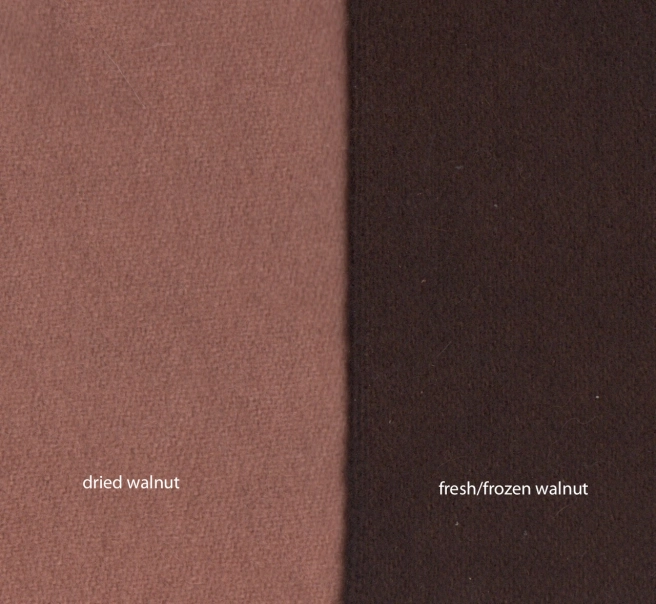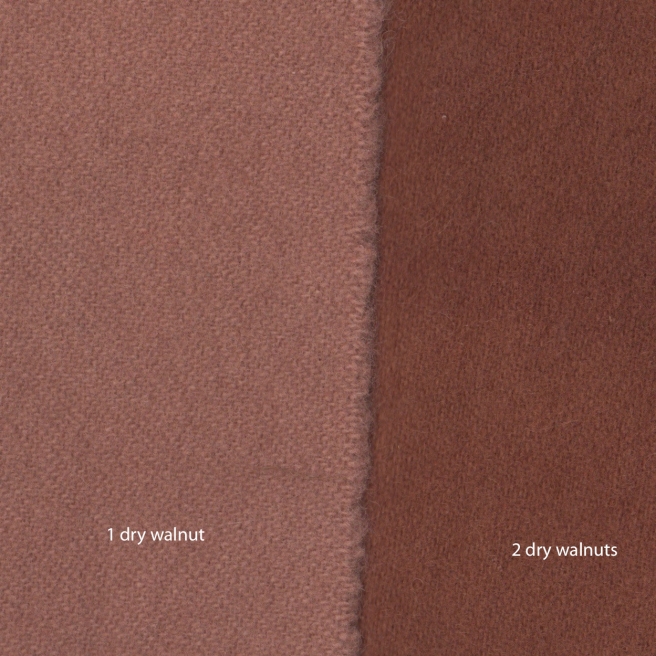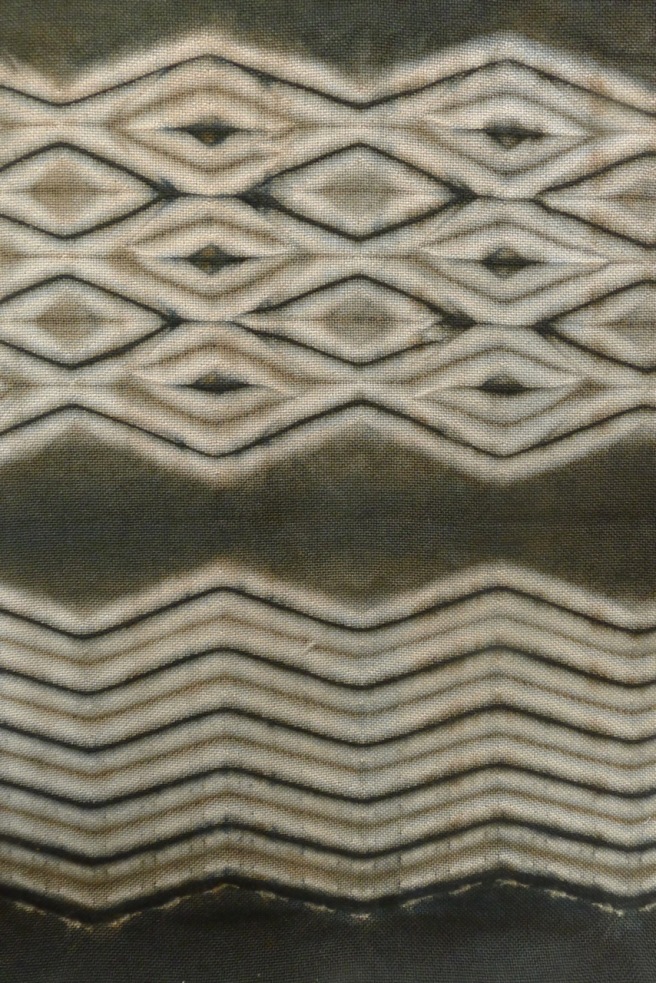
It’s time to collect black walnuts! The black walnut tree (Juglans nigra) is native to eastern North America. The outer husk of the nut is the source of dye. The colorant is juglone. It is a direct dye, which means that no mordant is necessary when used with a protein fiber. There are some tannins in the husk but that is very secondary to the strong juglone. I have not found a better dye to achieve a rich, fast, brown on protein fibers. Cellulose may be dyed as well, but that requires a mordant.
The best time to gather the nuts is when they are still green: newly fallen or ready to fall off the tree. If the nuts rot and turn black on the ground the dye will be damaged. I preserve the fresh nuts in the freezer for year round dyeing.
I have experimented with drying the nuts carefully on racks to prevent rotting. When I compared these dried nuts to fresh/frozen walnuts in the dyebath it was clear that they contain far less dye. On the other hand, drying may be a practical solution.


I have learned that the secret to dyeing with black walnut is slow dyeing and lots of patience. I put the entire nut(s) in a mesh bag (fresh or dry), cover with water and simmer until the outer skin (the exocarp) breaks open, releasing the soft husk underneath which contains the dye. Then I cool the bath a bit, add the fiber, leaving the entire nut in the bath (in the mesh bag) during the entire dyeing process. The mesh keeps the fiber clean. I heat the dyebath slowly and leave it for a long time. There were many occasions that I was disappointed in walnut dye, only to finally learn that it takes TIME. I still have to resist the temptation to add more walnut to the bath during the first hour of dyeing, remembering that the dye will get darker with a longer bath.


My typical approach to dyeing with walnuts is to grab a handful of them, making a good “guess” as to how many I need. I decided to approach the dyeing more scientifically in order to control the color and know how many walnuts were actually required to obtain the color I wanted.
A fresh walnut weighs about 90 grams. A dry walnut weighs about 30 grams. The dry nut contains a lot less water and now I know that it also contains a lot less dye.
- The nut inside the husk (this is the not the dye) = approx. 20 g
- A fresh nut contains approx. 70 g of walnut dye material
- A dry nut contains approx. 10 g of walnut dye material.
I now calculate about one fresh/frozen nut per 20 grams of fiber (or about 350% w.o.f.). If I am using dry walnuts I will double that amount, at least. Many more dry walnuts will be required to achieve the same color as the fresh walnuts.
Black walnuts are a most versatile dye. The presence of tannin means that the color can be dulled and deepened with an afterbath of ferrous but when dyed over a deep indigo, a near black color can be achieved on wool or silk without the use of any mordant.


Catharine’s new edition of Woven Shibori, focused on natural dye, is available from local booksellers or Amazon.com



Another very informative and beautifully illustrated article. I eagerly look forward to each of your posts. Thank you from a dyeing and textile addict!
Hi, I have a lot of brown wool so I’ll probably be dyeing linen with walnuts this fall. (This is an off year and there are very few walnuts on the trees or on the ground.) My usual cellulose mordant is alum-tannin-alum. Do you think this will work ok with walnut? Thanks.
—shannon
>
I would go ahead with the mordant method you typically use for cellulose.
I, too enjoy reading your blogs . The color achieved with the fresh walnut and the overnight dye bath is absolutely beautiful. Would love to try this someday.
Hey Catharine, just today I was out walking the neighborhood looking for black walnuts. I found English ( which might be j. Cinera) and butternuts. Then finally a single tree down by the river. I’m still in the PNW so different trees. I really appreciate your research. I always thought the more rotten the hull, the better the dye, but then I always put a lot of walnuts in the pot. I’ll try fewer and fresher and lots of time. I’ll be back in AVL July 2017. Hope to see you again.
Great to hear from you Chad. Let me know how the dyeing goes with the nut hulls from the PNW.
I love the colours you have achieved, and thank you for being scientific! I had a go with a few fresh and dried UK walnuts and loved the rich brown (like your dried 2) I got on unmordanted wool. I hadn’t realised drying them loses dye, that’s going to be more dye stuff in my freezer!!
Terrific Web page, Stick to the very good job.
Thank you. http://X23x.org/userinfo.php?uid=93977
Loving your page!! Thank you for your articles! question- if the walnuts have tannin, why do cellulose fibers need to be premordanted? wouldn’t the dye act as both a mordant and dye?
Walnuts have some tannin, but not a lot. The dye is mostly juglone. But even if there were tannin – tannin is NOT a mordant. The role of the mineral mordant is very different from a tannin, although tannins do assist with the attachments of mordants to cellulose. Mordants are mineral salts and include alum and iron.
The squirrels seem to get our walnuts. Is there dye in the leaves?
Yes, there is dye in the leaves but they are primarily flavonoids – yellows – and do require a mordant. The leaves are scarce right now, as most of them have fallen off the trees. Best to collect them in early to mid summer. They dry nicely, too.
Do you know if there is any juglone in the twigs? Walnut fruits seem uncommon where I live but I have a tree in my garden…
I’ve never dyed with the twigs but all parts of the plant do seem to have dye: bark, nut hulls, leaves, and wood. Dominique Cardon refers to the walnut tree as a “great living laboratory of dye production”. It would certainly be worth trying.
Hello, Catharine!
Can you please clarify something for me? Is the green portion of the walnut called the “hull” and the hard shell portion called the “husk”? If so, is it the hull (green) or the husk (shell) that contains the dye? When you say that you preserve the fresh nuts, do you mean with the hull intact? Every time I think I understand, I read something else and am confused all over again! Thank you for your time!
Hi Jamie, I use the terms “hull” and “husk” both to describe the green outer shell of the walnut. Cardon refers to it as both the “hull” and the “husk”. Language can be confusing! That hull/husk is the source of the dye. Inside that is a very hard shell that protects the nut itself. The shell is very difficult to break, and for that reason black walnuts are a precious treat. I put the entire thing (hull/husk with the nut intact) in my dyebath. Hope that clears things up.
THANK YOU! It clears everything up. 🙂
Hi,
I am a reenactor and am new to the dyeing scene. I have a frock (think revolutionary war, wrap around garment… looks very ‘Daniel Boone’) and am looking to turn the shade from a light tan to a deep woodland brown. The goal is to blend in with the woods of Ohio a little better. The fabric is called linette, it is composed of half linen and half cotton. I have plenty of walnuts from my property and want to be sure before I commit to this project that this fabric will accept the dye. Any comments or suggestions?
Thanks
Hi Alex,
If you are dyeing cotton/linen with black walnut hulls, you will need to mordant the garment first. Otherwise the dye will not attach. The garment should be treated with tannin first, and then apply the mordant. We will have very specific instructions for this mordanting in our new book, The Art and the Science of Natural Dye but since that will not be out until later in the fall, you might refer to Jim Liles book, The Art and Craft of Natural Dyeing. Jim was a re-enactor himself and that motivated much of his research and dyeing. Apply the tannin, as he suggests, followed by one of the alum mordant recipes for cellulose.
I have read about juglone as a toxin contained in the hulls of black walnuts. should one be concerned while boiling/extracting dye that you’re inhaling juglone?
The juglone is toxic to other plants in the vicinity – for instance, you don’t want a black walnut tree near your vegetable garden as it is toxic to those plants through the root system. I don’t believe there is any danger in boiling or breathing the juglone, but best to always work in a well-ventilated area. I have never had an issue with cooking black walnuts and have not heard of anyone else having an issue.
I have your excellent book and have been following the sequence of tannin first, then alum, then dye, with success on Kona cotton. However, I’ve read in other books that the sequence of tannin then alum could be reversed. (alum first, then tannin, then dye). What do you think? The alum I use is McCormick pickling alum–potassium aluminum sulfate.
I asked the above question b/c I have some alum mordanted fabric to which I have not applied tannin and would like to put it in a black walnut bath. I was wondering if I should go ahead and apply the tannin before I put it in the dye, or if the walnuts–I have used a five gallon bucket full of fresh hulls–might contain enough tannin already, and if that sequence would even work… Thanks so much.
The mordant does not have any affinity for a cellulose textile, unless a tannin has been applied first. Then the mordant attaches to the tannin and becomes permanently bound to the textile. That is why the tannin is applied first. I don’t think it will work well in the reverse direction but you can certainly try it. You might try applying a tannin and re-mordanting and compare results. BTW, black walnuts contain lots of jugulan (the coloring matter) but not as much tannin as you might think.
Thanks for clearing that up. There’s a lot of conflicting information out there!
Is dye in the green outer part or is it in the hard shell inside? I’m confused because when the green ones ripen and get smashed in the driveway, they stain the concrete. Or is the inner shell that leaves the stain? I hope someone can clarify this for me. Thanks.
Yes, it is the green, outer husk. It’s best to use them when they are still green, before they have turned dark.
Does boiling wool shrink it? I am having trouble finding info on the web. I have some wool clothing articles that I want to dye with black walnuts. How do I avoid shrinking?
Thanks!
Wool should never be boiled. Long, slow dye baths with black walnuts will not damage the wool. Keep the temperature at about 180 degrees F. and treat the fiber gently. Agitation will result in felting.